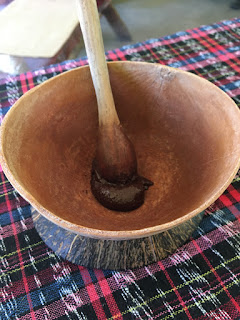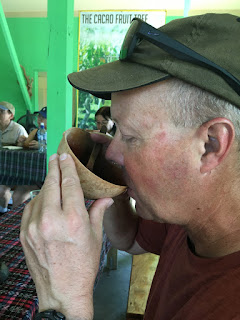As I mentioned in another post, San Ignacio is very close to the
Guatemalan border. Tikal, perhaps the most well-known Mayan ruin, is
just across that border. The process to get to Tikal wasn’t very
difficult.
We signed up with PAK Tours, located in downtown San Ignacio, for the
Tikal package. PAK basically took care of everything. I’ve read
online that it’s cheaper to do it yourself, but with the tensions
between the two countries, and reports of robberies/beatings of tourists
traveling in this area of Guatemala, we decided that this would not be
an area to cheap out on. Also, while there are many choices for tour
guides, we do recommend PAK tours. Our guide was respectful,
knowledgeable, and a good communicator. Our interactions/observations
with other tour guides at Tikal were at times less favorable.
Early in the morning, seven of us piled into a large Toyota van and
drove the twenty minutes or so to the Guatemalan border. All of the
border crossing fees are paid by the PAK driver/guide as part of the
tour package. He escorted us through the Belize side where we received
our passport departure stamps and then through the Guatemala side where
we received our arrival stamps. A Guatemalan driver waited with a
different Toyota van to take us to Tikal.
On the way we stopped at a small store where free Guatemalan coffee
was freshly brewed and offered to tour groups stopping by. This was the
only good cup of coffee that I had the whole trip, so I had several.
No sugar or cream needed.
Once we arrived at Tikal, we were on foot the rest of the way. The
first thing our guide said was that we would be walking about five miles
with quite a few optional steps. We are both capable of doing that
with no problem, but not everyone on the van was in good shape, and some
people chose not to walk all of the steps to the top of various
buildings. Due to the walk, grades, narrow jungle paths, and steps,
this would not be an appropriate tour for everyone.
Within the first fifteen minutes of walking through the jungle, we
saw our first howler monkeys. As you might expect, they were really
loud. Apparently, they are known to poop on tourists, but we missed out
on that experience.
One of the amazing things about Tikal is the size of the complex.
Multiple temples were planned and built in accordance with the rising
and setting sun, along with true north and south. From the jungle
floor, one sees only the complex of temple, palace, and other buildings.
But from the top of specific temples, the entire conceptual plan
becomes evident. You get to see that only by climbing a thousand or so
steps.
The
howler monkeys were not our only encounters with nature on this trip.
At one of the plazas, we were visited by a Coati, which is a racoon-like
mammal common in Guatemala. Unfortunately, a French tourist chased it
around the plaza, trying to get the perfect photograph. Sometimes, I
don’t like people very much.
The
most exciting encounter that we had with nature occurred just off a
well-traveled path on the way up to one of the palaces. A small group
of tourists were standing in a half circle with their guide, focused
upon something on the ground. As we drew closer, we saw that it was a
small snake. The tourists’ guide (not our guide) began clapping at the
snake to get it to move or perform or whatever. It turned out to be a
fer-de-lance.
We
moved on quickly, hoping that the group of people would let the snake
alone and get to wherever it wanted to get. After taking in the views
at the top of the palace, we returned the same way. The small crowd had
moved on, and we were on high alert, as this snake blends very well
into the ground cover. I wasn’t worried about the snake attacking
us–more stepping on it inadvertently. Further down the trail, we saw
another guide about a dozen steps off the trail, quietly watching
something on the ground. “Fer-de-lance?” I asked. He nodded silently.
“A second one?” I asked. “Yes,” he answered. To his credit, he was
just making sure that it moved away from where people were walking.
Our guide told us that thatched roofs are common in this region. As
deforestation has increased, the workers harvesting palm tree leaves
have needed to go deeper into the jungle to find materials. These
extremely poisonous snakes are usually found in the palm trees–sometimes
by the workers. “The cost of the labor has increased,” our guide
said. “This is very dangerous work now.”
I spent a lot of time looking at the ground for the rest of the Tikal tour.
Our
Tikal trip was probably the highlight of our adventure in the Belize
area. We are back in Wisconsin now and enjoying some snow . Julia is
cross-country skiing. Callie and I are snowshoeing. Our journey to the
tropics was a welcome respite, but we do enjoy our seasons.
The next scheduled trip is to take the Brew Hut south in April.
Yesterday, I had to use the heat gun to open up the Scamp’s door, which
had frozen shut. I replaced a troublesome electrical outlet, which
seemed to also solve the problem with a fluorescent light on the same
circuit. There are still a few more repairs on my list. Other than
that, I’m hoping for milder weather in early April so that I can get the
trailer down from a steep, ice-covered hill where it is stored.































































